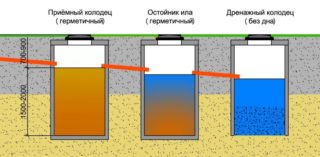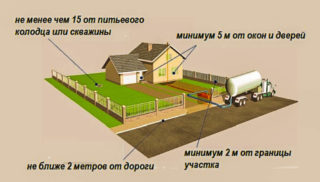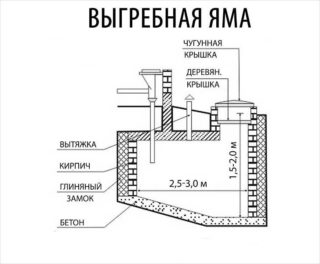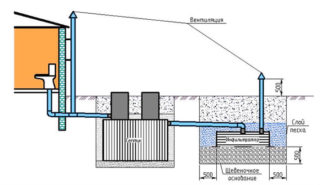Wastewater removal is needed for both private houses and industrial premises. But it is not always possible to connect to a centralized network. In such a situation, it is required to install an autonomous sewer system. You can buy a ready-made sewage treatment plant and invite specialists to install it on the site. But it is more economical to build an autonomous sewage system with your own hands.
Types of treatment facilities for a private house

Before proceeding with the local sewage system in a private house with your own hands, the type of treatment plant is selected. The layout of the highways and the technology of their installation depend on this.
Sealed cesspool
This is a classic wastewater reservation. The construction of the pit is not difficult and cheap, but in terms of technological characteristics, the design is inferior to modern sewage treatment devices. A tank made of concrete rings, a brick mine requires rather frequent pumping out of the contents.
When creating a cesspool, it is necessary to give airtightness to the walls or the bottom, especially if you permanently live in a private house, or if the volume of sewage in the country is more than a cube per day.
Septic tanks
Septic tanks are available in both single-chamber and multi-chamber versions. Due to additional biological treatment with the help of anaerobic bacteria, the time intervals between the pumping of contaminated water are increased. Some systems can achieve purification up to 95 percent and use water for process needs. But building such a device yourself is difficult.
Tanks for septic tanks are made of bricks, concrete, large plastic barrels.
If funds are available, it is easier to purchase a ready-made plastic septic tank, a local-type cleaning station or an automatic unit. It is almost impossible to mount such a device on your own. If you need special equipment, you will have to hire professionals.
Sewerage construction stages
The device of an autonomous sewage system in a private house with your own hands is not as difficult as it seems, with proper design and careful installation work.
Design work
When drawing up a home sewage project, it is necessary to consider:
- Average amount of water consumption per day. The capacity must hold at least three daily average rates.
- The total number of drain points.
- Terrain relief. The cleaning or storage facility is located at the lowest level.
- Standard distance between highways and the distance from them to buildings.
Before selecting an autonomous sewage system, the soil composition is analyzed in the territory where the place for sewage drains will be located. Only in non-acidic and loose soil are microorganisms that are able to naturally process waste into organic matter. The lands are heavy and clayey - empty, no beneficial bacteria live in them. In addition, water practically does not pass through the clay. On such soils, it is advisable to install sealed tanks with pumping or bioremediation systems.
The groundwater level is also checked.A septic tank or cesspool should be installed so that drains do not contaminate subsurface sources. If the water table is high, additional installation of a filtration well will be required. When laying sewer lines, the depth of soil freezing is also important. The pipeline must be buried below this mark.
When calculating the average daily volume of water, not only the number of people permanently living in the house is taken into account, but also those people who come to visit.
The drain well should be located away from buildings or a water intake source so that there are no problems with the environment and the health of residents.
Sewer system installation
Devices created on the basis of concrete rings are popular among owners of small private houses. To create them, you will have to call special equipment, for example, a crane for lowering structural elements into the pit, but still such a treatment plant is optimal in terms of price and quality.
The scheme for creating an autonomous sewage system from concrete rings includes the following points:
- The drives are mounted on a concrete base. It is the bottom of the treatment plant and requires a waterproofing coating. In a septic tank for one chamber, this condition is mandatory. If the device involves two chambers, then a waterproof bottom is made in the first, and in the second it can be replaced with a filter membrane. Through it, the clarified water will go into the soil. If the installation has three chambers, the bottom is sealed in the first two, and a filter membrane is installed in the third.
- The depth of the septic tank depends on the number of concrete products and their height. Usually three such elements are put. But the volume of the treatment plant is determined not only by this indicator. The section of the concrete rings is taken into account.
- The installation of the rings on top of each other must be very accurate so that the elements dock without gaps. Small gaps are removed with concrete mortar. If the septic tank is deep, it is advisable to apply the solution to the joints of the rings.
- To remove communications, holes are drilled in the rings with a perforator. When the pipe is in place, the gaps are also filled with concrete and a layer of waterproofing.
If a sewer of this type consists of several tanks with overflows, there must be pipe connections at the top. They are needed for the transfer of fluid from one reservoir to another and consistent purification. Each of them is located slightly lower at the entrance than the previous one. The first is mounted at a distance of less than 250 mm from the edge of the upper ring.
Ventilation devices
If cleaning bacteria are used, it is advisable to install an aerator. It is needed to supply more oxygen to microorganisms. The device is easy to make yourself, remove the pipe from the septic tank, like a riser, and plug it off at the top. Weld the inlet to the side for forced air injection.
Also, for better ventilation, vacuum valves are installed. It is better to combine them with funnel pipes, since they alone will not provide sufficient ventilation.
After the installation of the septic tank and the pipelines leaving it, the internal system is being wired in the sanitary rooms of the building. Sewer pipes must be hermetically docked with the outputs of the main sections coming from the septic tank.











